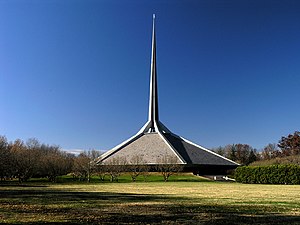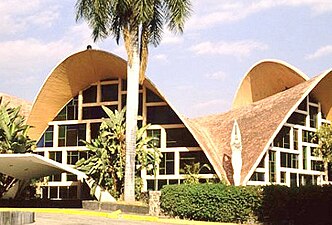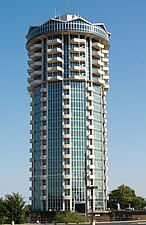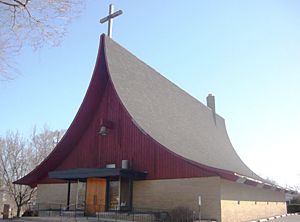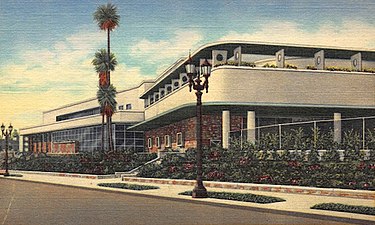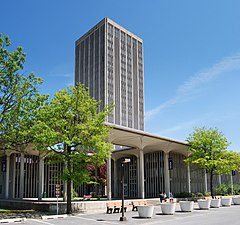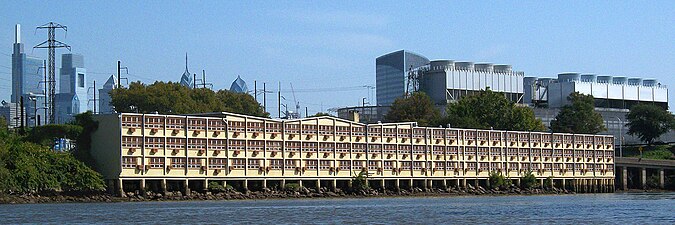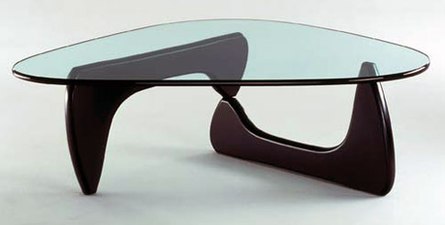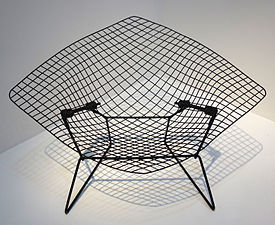Mid-century modern
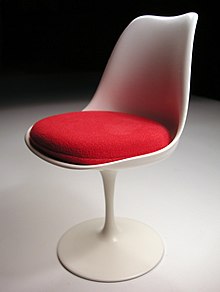
Mid-century modern (MCM) is a movement in
The term was used as early as the mid-1950s, and was defined as a design movement by Cara Greenberg in her 1984 book Mid-Century Modern: Furniture of the 1950s. It is now recognized by scholars and museums worldwide as a significant design movement.
The MCM design aesthetic is modern in style and construction, aligned with the Modernist movement of the period. It is typically characterized by clean, simple lines and honest use of materials, and generally does not include decorative embellishments.
Architecture
This section needs additional citations for verification. (March 2012) |
International, Bauhaus |

The mid-century modern movement in the U.S. was an American reflection of the
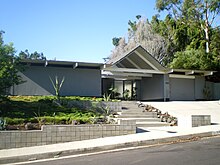
In Europe, the influence of Le Corbusier and the
Pioneering builder and real estate developer Joseph Eichler was instrumental in bringing Mid-century modern architecture ("Eichler Homes") to subdivisions in the Los Angeles area and the San Francisco Bay region of California, and select housing developments on the east coast. George Fred Keck, his brother Willam Keck, Henry P. Glass, Mies van der Rohe, and Edward Humrich created Mid-century modern residences in the Chicago area. Mies van der Rohe's Farnsworth House is extremely difficult to heat or cool, while Keck and Keck were pioneers in the incorporation of passive solar features in their houses to compensate for their large glass windows.
Mid-century modern in Palm Springs
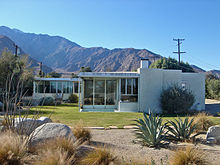
The city of Palm Springs, California is noted for its many examples of Mid-century modern architecture.[4][5][6][7][8][9][10][excessive citations]
- Welton Becket: Bullock's Palm Springs (with Wurdeman) (1947) (demolished, 1996[13])
- John Porter Clark: Welwood Murray Library (1937); Clark Residence (1939) (on the El Minador golf course); Palm Springs Women's Club (1939)
- William F. Cody: Stanley Goldberg residence;[14] Del Marcos Motel (1947); L'Horizon Hotel, for Jack Wrather and Bonita Granville (1952); remodel of Thunderbird Country Club clubhouse (c. 1953) (Rancho Mirage); Tamarisk Country Club (1953) (Rancho Mirage) (now remodeled); Huddle Springs restaurant (1957); St. Theresa Parish Church (1968); Palm Springs Library (1975)
- Craig Ellwood: Max Palevsky House (1970)
- Albert Frey: Palm Springs City Hall (with Clark and Chambers) (1952–57); Palm Springs Fire Station #1 (1955); Tramway Gas Station (1963); Movie Colony Hotel; Kocher-Samson Building (1934) (with A. Lawrence Kocher); Raymond Loewy House (1946); Villa Hermosa Resort (1946); Frey House I (1953); Frey House II (1963); Carey-Pirozzi house (1956); Christian Scientist Church (1957); Alpha Beta Shopping Center (1960) (demolished)
- Chapelle Notre Dame du Haut, Ronchamp, by Le Corbusier)
- A. Quincy Jones: Palm Springs Tennis Club (with Paul R. Williams) (1946); Town & Country Center (with Paul R. Williams) (1947–50); J.J. Robinson House (with Frederick E. Emmons) (1957); Ambassador and Mrs. Walter H. Annenberg House (with Frederick E. Emmons) (1963); Country Club Estates Condominiums (1965)
- William Krisel:[16] Ocotillo Lodge(1957); House of Tomorrow(1962).[17]
- John Lautner: Desert Hot Springs Motel (1947); Arthur Elrod House (1968) (interiors used in filming James Bond's Diamonds Are Forever); Hope Residence (1973)
- John Black Lee: Specialized in residential houses. Lee House 1 (1952), Lee House 2 (1956) for which he won the Award of Merit from the American Institute of Architects, Day House (1965), * System House (1961), Rogers House (1957), Ravello (1960)
- Gene Leedy: The Sarasota School of Architecture, sometimes called Sarasota Modern, is a regional style of post-war architecture that emerged on Florida's Central West Coast.
- Frederick Monhoff: Palm Springs Biltmore Resort (1948) (demolished, 2003[13])
- Richard Neutra (Posthumous AIA Gold Medal honoree): Grace Lewis Miller house (1937) (includes her Mensendlieck posture therapy studio);[18] Kaufmann Desert House (1946);[19] Samuel and Luella Maslon House, Tamarisk Country Club, Rancho Mirage (1962) (demolished 2003)[13]
- William Pereira: Robinson's (1953)
- William Gray Purcell (with protégé Van Evera Bailey): Purcell House (1933) (cubist modern)
- Donald Wexler: Steel Developmental Houses,[20] Sunny View Drive (1961). Home developer, Alexander Homes, popularized this post-and-beam architectural style in the Coachella Valley. Alexander houses and similar homes feature low-pitched roofs, wide eaves, open-beamed ceilings, and floor-to-ceiling windows.[7]: 66–75
- Palm Springs Desert Museum(1976)
- Paul Williams: Palm Springs Tennis Club (with Jones) (1946)
- Frank Lloyd Wright Jr.: Oasis Hotel (1923)
- Walter Wurdeman: Bullock's Palm Springs (with Welton Becket) (1947) (demolished 1996)[13]
Examples of 1950s Palm Springs motel architecture include Ballantines Movie Colony (1952) – one portion is the 1935 Albert Frey San Jacinto Hotel – the Coral Sands Inn (1952), and the Orbit Inn (1957).[21] Restoration projects have been undertaken to return many of these residences and businesses to their original condition.[22]
Case study houses
The Case Study Houses was a program creating a series of architectural prototype-homes involving major mid-century architects, including Charles and Ray Eames, Craig Ellwood, A. Quincy Jones, Edward Killingsworth, Pierre Koenig, Richard Neutra, Ralph Rapson, Eero Saarinen, and Raphael Soriano to design and build modern efficient and inexpensive model homes for the post-WWII residential housing boom in the United States. The program began in 1945 and lasted through 1966. The houses were documented by architectural photographer Julius Shulman.[23][24]
Industrial design

Social medium
Printed ephemera documenting the mid-century transformations in design, architecture, landscape, infrastructure, and entertainment include mid-century linen post cards from the early 1930s to the late 1950s. These post cards came about through innovations pioneered through the use of offset lithography. The cards were produced on paper with a high rag content, which gave the post card a textured look and feel. At the time this was a less expensive process. Along with advances in printing technique, mid-century linen postcards allowed for very vibrant ink colors. The encyclopedic geographic imagery of mid-century linen post cards suggests popular middle-class attitudes about nature, wilderness, technology, mobility and the city during the mid-20th century.[27]
Curt Teich in Chicago[28] was the most prominent and largest printer and publisher of Linen Type postcards[29] pioneering lithography with his "Art Colortone" process.[30] Other large publishers include Stanley Piltz in San Francisco, who established the "Pictorial Wonderland Art Tone Series", Western Publishing and Novelty Company in Los Angeles and the Tichnor Brothers in Boston.[31] The printing of mid-century linen post cards began to give way in the late 1950s to Kodachrome and Ektachrome color prints.
Examples
Architecture
-
Main Terminal atDulles Airport in Northern Virginia, by Eero Saarinen
-
Palacio da Alvorada, official residence of the President of Brazil, by Oscar Niemeyer
-
North Christian Church, Columbus, Indiana, US, the final work of Eero Saarinen
-
Stahl House, designed by Pierre Koenig
-
Helsinki, Finland – University of Technology – Auditorium, by Alvar Aalto
-
Sierra Towers in West Hollywood, California, by Jack A. Charney
-
Hotel Casino de la Selva, Cuernavaca, Mexico, by Félix Candela
-
The 360 at Founders Plaza in Oklahoma City
-
Courthouse Annex Building, (now demolished) Jacksonville, Florida, by Reynolds, Smith & Hills
-
Del Prado Condominiums,Balboa Park, San Diego, by William Krisel
-
UCI Langson Library, Irvine Ranch, California
-
Bullock's Pasadena, California, 1949
-
Alden Dow House and Studio, Midland, Michigan, by Alden B. Dow
-
Adventkerk, The Hague, the Netherlands, by K.L. Sijmons, 1954
-
State Quad, one of four identical quadrangle dormitories, at theUniversity at Albany, New York
-
University Motor Inn with partial butterfly roof on the Schuylkill River in Philadelphia, 1960
Furniture
-
Comprehensive Storage Unit by George Nelson
-
A mid-century modern flair applied to arecord player
Additional notable names
- Aino Aalto
- Magdalena Abakanowicz
- Gregory Ain
- Adela Akers
- Anni Albers
- Joyce Anderson
- Ruth Asawa
- Alfons Bach[32]
- Milo Baughman
- Al Beadle
- Harry Bertoia
- Lili Blumenau
- Robin Boyd
- Marcel Breuer
- Robert C. Broward
- Mary Buskirk
- Jack Allen Charney
- Katherine Choy
- Victor Christ-Janer
- William Curry
- Greta Daniel
- Edward D. Dart
- Lucia DeRespinis
- Richard Lee Dorman
- Charles and Ray Eames
- Joseph Eichler
- Arthur Erickson
- O'Neil Ford
- Paul T. Frankl
- Elsie Freund
- Bertrand Goldberg
- Charles Goodman
- Max Gottschalk
- Eileen Gray
- Lawrence Halprin
- Paul Hamilton
- Eszter Haraszty
- Taylor Hardwick
- Ralph Haver
- Frances Stewart Higgins
- Michael Higgins
- Finn Juhl
- Vladimir Kagan
- Louis Kahn
- Poul Kjaerholm
- Kaare Klint
- Henry Klumb
- Pierre Koenig
- Florence Knoll
- William Krisel
- Mogens Lassen
- Paul Laszlo
- John Lautner
- Roger Lee
- Charles Luckman
- Carl Maston
- Cliff May
- Paul McCobb
- John Randal McDonald
- Leza McVey
- Emil Milan
- Eudorah Moore
- William Morgan
- Børge Mogensen
- George Nelson
- Oscar Niemeyer
- Svend Nielsen
- Isamu Noguchi
- Verner Panton
- Tommi Parzinger
- Adrian Pearsall
- Ruth Penington
- Walter Pierce
- Warren Platner
- Jean Prouvé
- Ira Rakatansky
- Merry Renk
- Jens Risom
- Paul Rudolph
- Eero Saarinen
- Richard Schultz
- Paul Schweikher
- Harry Seidler
- Avriel Shull
- Mel Smilow
- Maurice K. Smith
- Alison and Peter Smithson
- Raphael Soriano
- Russell Spanner
- Marianne Strengell
- Edward Durell Stone
- Art Troutner
- Ole Wanscher
- Hans Wegner
- David Weidman[33]
- Russel Wright and Mary Wright
- Eva Zeisel
See also
- Atomic Age
- Butterfly roof
- Case Study Houses
- Danish modern
- Dingbat
- Googie architecture
- Miami Modern architecture
- Miller House
- Modern architecture
- Modernism
- Populuxe
- United Productions of America
References
- ^ "Understanding Mid-Century Modern and How To Use it in Your Home". September 29, 2017.
- ^ "Mid-century modern is the style that won't die". The Washington Post. June 13, 2023.
- ^ Jason Peterson (2014-02-01). "Designer Spotlight: Florence Knoll". Emfurn. Retrieved 2015-05-23.
- ^ Wills, Eric (May–June 2008). "Palm Springs Eternal". Preservation. 60 (3): 38–45.
- LCCN 98048811.
- LCCN 2007933610.
- ^ LCCN 00024046.
- ISBN 978-1840914061.
- OCLC 475457720.
- ^ "Desert Modernism Timeline". Palm Springs Modern Committee. Retrieved 15 February 2017.
- ^ Goldberger, Paul (May–June 2008). "The Modernist Manifesto". Preservation. 60 (3): 30–35.
- ^ "The Time: Modern: Highlights in the development of modernism in the Coachella Valley". Palm Springs Life. Palm Springs, CA. February 2007. Archived from the original on 2015-06-15.
- ^ a b c d "Lost: Maslon House". Palm Springs Preservation Foundation. Retrieved 15 February 2017.
- ^ "A Winter Residence in Palm Springs" (PDF). Architectural Digest. Fall 1967. Archived from the original (PDF) on February 17, 2016. Retrieved May 23, 2012.
Interior Design by Arthur Elrod, A.I.D. and William Broderick, A.I.D.; Architecture by William Cody, F.A.I.A.
- ^ "Palm Springs Preservation Foundation: Then and Now". Palm Springs Preservation Society. Archived from the original on 2016-03-07.
- ^ "William Krisel". Palm Springs Modern Committee. Retrieved 15 February 2017.
- ^ Bradley, Darren (29 June 2013). "Modernist Architecture: William Krisel". modernistarchitecture.blogspot.com. Retrieved 15 February 2017.
- LCCN 2003021531.
- LCCN 2009032574.
- LCCN 2010043639.
- ^ Howser, Huell (September 27, 2002). "'50s Motel – Palm Springs Week (20)". California's Gold. Chapman University Huell Howser Archive.
- ^ Colacello, Bob; Becker, Jonathan (photographs) (June 1999). "Palm Springs Weekends" (PDF). Vanity Fair: 192–211. Archived from the original (PDF) on 2013-12-11.
- ISBN 9780262692137. Retrieved 25 March 2024.
- ISBN 9783836535601. Retrieved 25 March 2024.
- ^ Zahid Sardar (2004-02-01). "Home Is Where the Heath Is: A Bay Area pottery tradition continues under new ownership". San Francisco Chronicle. Retrieved 2006-09-14.
- ^ "Tamac Plate: Decorative Arts". Brooklyn Museum. Retrieved 13 May 2022.
- .
- ^ Curt Teich Postcard Archives, Lake County Discovery Museum. Retrieved March 4, 2012.
- ^ Metropolitan Postcard Club of New York City. Retrieved March 4, 2012.
- ^ "An Offset Pioneer" in: American Printer, October 1, 2006.
- ^ Tichnor Brothers Collection, Boston Public Library.
- ^ Mayhew, Augustus (11 July 2011). "Urbane Developments: Miami & Delray". New York Social Diary. Retrieved 6 February 2017.
- ^ Saperstein, Pat (2014-08-07). "David Weidman, Animation Artist Whose Work Appeared on 'Mad Men,' Dies at 93". Variety. Retrieved 2014-08-29.
Further reading
- ISSN 0028-792X. Archived from the original(PDF) on 2014-03-17. Retrieved May 23, 2012. (Abstract: Chronicles the return to fashionability of Palm Springs, including the post-WWII architecture of John Lautner, Richard Neutra, and Albert Frey.)
- Coquelle, Aline (2006). Palm Springs Style. Assouline. p. 192. ISBN 978-2843237430.
- Dailey, Victoria (2003). LA's Early Moderns: Art, Architecture, Photography. Princeton Archit. Press. p. 136. ISBN 978-1890449162.
- Dietsch, Deborah K. (2000). Classic Modern: Midcentury Modern At Home. Simon & Schuster. p. 208. ISBN 978-0684867441.
- Greensberg, Cara (2000). Mid-Century Modern: Furniture of the 1950s. London: Thamse & Hudson. OL 1984249W.
- ISBN 978-1586858582.
- Keith, Michele (2010). "Michael Berman: ... Palm Springs; Alex Jordan: ... Palm Desert". Designers here and there: inside the city and country homes of America's top decorators. New York: Monacelli Press. p. 224. LCCN 2009042910.
- Dream Homes Deserts: A Showcase of the Finest Architects, Designers & Builders in Las Vegas, Palm Springs & New Mexico. Dallas, TX: Panache Partners. 2008. p. 200. ISBN 978-1933415284.
- "Desert Classic". landmark by respecting both its architecture and view.
- "A spectacular renovation in Palm Springs respects the past but pushes the midcentury feel into the future". OCLC 14634311.
- "Palm Springs Infusion: Splashes of color and sophistication revive a desert house". Architectural Digest. New York. February 2008.
- "Jim Jennings Emphasizing Form & Light in his Elegantly Spare Palm Springs Retreat". Architectural Digest. New York. September 2009.
- "At Home in the Desert ... a house near Palm Springs". Architectural Digest. New York. April 2010.
External links
- Renovations and Additions to a 1940s Mid Century Modern Residence in Pasadena by architect James V. Coane & Associates (2017 archive)
- Desert Utopia: Mid-Century Architecture in Palm Springs, documentary about Mid-Century Modern in Palm Springs





